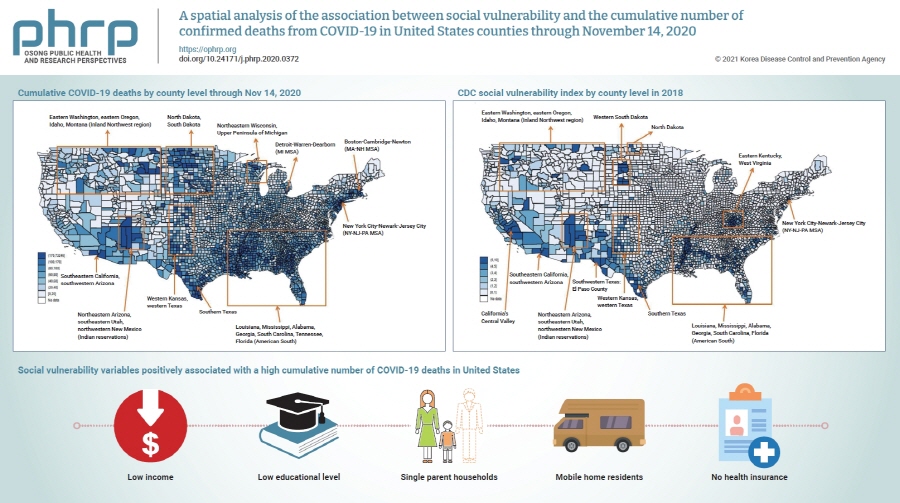Search
- Page Path
- HOME > Search
Original Article
- A spatial analysis of the association between social vulnerability and the cumulative number of confirmed deaths from COVID-19 in United States counties through November 14, 2020
- Baksun Sung
- Osong Public Health Res Perspect. 2021;12(3):149-157. Published online June 2, 2021
- DOI: https://doi.org/10.24171/j.phrp.2020.0372
- 6,660 View
- 150 Download
- 4 Web of Science
- 5 Crossref
-
 Graphical Abstract
Graphical Abstract
 Abstract
Abstract
 PDF
PDF 
- Objectives
Coronavirus disease 2019 (COVID-19) is classified as a natural hazard, and social vulnerability describes the susceptibility of social groups to potential damages from natural hazards. Therefore, the objective of this study was to examine the association between social vulnerability and the cumulative number of confirmed COVID-19 deaths (per 100,000) in 3,141 United States counties.
Methods
The cumulative number of COVID-19 deaths was obtained from USA Facts. Variables related to social vulnerability were obtained from the Centers for Disease Control and Prevention Social Vulnerability Index and the 2018 5-Year American Community Survey. Data were analyzed using spatial autoregression models.
Results
Lowest income and educational level, as well as high proportions of single parent households, mobile home residents, and people without health insurance were positively associated with a high cumulative number of COVID-19 deaths.
Conclusion
In conclusion, there are regional differences in the cumulative number of COVID-19 deaths in United States counties, which are affected by various social vulnerabilities. Hence, these findings underscore the need to take social vulnerability into account when planning interventions to reduce COVID-19 deaths. -
Citations
Citations to this article as recorded by- Ecological comparison of six countries in two waves of COVID-19
Meiheng Liu, Leiyu Shi, Manfei Yang, Jun Jiao, Junyan Yang, Mengyuan Ma, Wanzhen Xie, Gang Sun
Frontiers in Public Health.2024;[Epub] CrossRef - Social vulnerability and COVID-19 in Maringá, Brazil
Matheus Pereira Libório, Oseias da Silva Martinuci, Patrícia Bernardes, Natália Cristina Alves Caetano Chav Krohling, Guilherme Castro, Henrique Leonardo Guerra, Eduardo Alcantara Ribeiro, Udelysses Janete Veltrini Fonzar, Ícaro da Costa Francisco
Spatial Information Research.2023; 31(1): 51. CrossRef - A county-level analysis of association between social vulnerability and COVID-19 cases in Khuzestan Province, Iran
Mahmoud Arvin, Shahram Bazrafkan, Parisa Beiki, Ayyoob Sharifi
International Journal of Disaster Risk Reduction.2023; 84: 103495. CrossRef - Global mapping of epidemic risk assessment toolkits: A scoping review for COVID-19 and future epidemics preparedness implications
Bach Xuan Tran, Long Hoang Nguyen, Linh Phuong Doan, Tham Thi Nguyen, Giang Thu Vu, Hoa Thi Do, Huong Thi Le, Carl A. Latkin, Cyrus S. H. Ho, Roger C. M. Ho, Md Nazirul Islam Sarker
PLOS ONE.2022; 17(9): e0272037. CrossRef - COVID-19 mortality and deprivation: pandemic, syndemic, and endemic health inequalities
Victoria J McGowan, Clare Bambra
The Lancet Public Health.2022; 7(11): e966. CrossRef
- Ecological comparison of six countries in two waves of COVID-19
Brief Report
- Introduction of the Republic of Korea–the United States of America's Joint Exercise Against Biothreats in 2013: Able Response 13
- Seong Sun Kim, Dong Whan Oh, Hyun Jung Jo, Chaeshin Chu
- Osong Public Health Res Perspect. 2013;4(5):285-290. Published online October 31, 2013
- DOI: https://doi.org/10.1016/j.phrp.2013.09.009
- 3,095 View
- 15 Download
- 8 Crossref
-
 Abstract
Abstract
 PDF
PDF - The Republic of Korea (ROK) and the the United States of America (USA) has held joint exercises to respond to biothreats in the Korean Peninsula since 2011. The exercise was called Able Response (AR) and it aims to coordinate interministerial procedures inside Korea and international procedures in requesting the medical resources urgently between ROK and USA, and among ROK and the United Nations, and nongovernmental organizations. AR13 was a functional exercise with a scenario that presumed a series of attack by terrorists, dispersing Bacillus anthracis in Seoul. The participants conducted exercises with action cells and using point-to-point communication system. It was followed by Senior Leadership Seminar participated by high-ranking officials in ROK and USA to discuss possible collaboration in advance. AR and its following actions will fortify collaboration between ROK and USA and enhance the capability of countermeasures against biothreats in Korea.
-
Citations
Citations to this article as recorded by- Developing Public Health Emergency Response Leaders in Incident Management: A Scoping Review of Educational Interventions
Yang Li, Edbert B. Hsu, NhuNgoc Pham, Xiaohong Mao Davis, Michelle N. Podgornik, Silvia M. Trigoso
Disaster Medicine and Public Health Preparedness.2022; 16(5): 2149. CrossRef - Biodefence research two decades on: worth the investment?
Carrie M Long, Andrea Marzi
The Lancet Infectious Diseases.2021; 21(8): e222. CrossRef - Militaries and global health: peace, conflict, and disaster response
Joshua Michaud, Kellie Moss, Derek Licina, Ron Waldman, Adam Kamradt-Scott, Maureen Bartee, Matthew Lim, Jamie Williamson, Frederick Burkle, Christina S Polyak, Nicholas Thomson, David L Heymann, Louis Lillywhite
The Lancet.2019; 393(10168): 276. CrossRef - A Joint Exercise against Intentional Biothreats
Hae-Wol Cho, Chaeshin Chu
Osong Public Health and Research Perspectives.2018; 9(1): 1. CrossRef - Enhancing ‘Whole-of-Government’ Response to Biological Events in Korea: Able Response 2014
Sangwoo Tak, Anton Jareb, Suon Choi, Marvin Sikes, Yeon Hwa Choi, Hyeong-wook Boo
Osong Public Health and Research Perspectives.2018; 9(1): 32. CrossRef - What is the value of health emergency preparedness exercises? A scoping review study
Elena Skryabina, Gabriel Reedy, Richard Amlôt, Peter Jaye, Paul Riley
International Journal of Disaster Risk Reduction.2017; 21: 274. CrossRef - Syndromic Surveillance System for Korea–US Joint Biosurveillance Portal: Design and Lessons Learned
Chulwoo Rhee, Howard Burkom, Chang-gyo Yoon, Miles Stewart, Yevgeniy Elbert, Aaron Katz, Sangwoo Tak
Health Security.2016; 14(3): 152. CrossRef - How to Manage a Public Health Crisis and Bioterrorism in Korea
Hae-Wol Cho, Chaeshin Chu
Osong Public Health and Research Perspectives.2013; 4(5): 223. CrossRef
- Developing Public Health Emergency Response Leaders in Incident Management: A Scoping Review of Educational Interventions



 First
First Prev
Prev


